4 Days in Quebec City
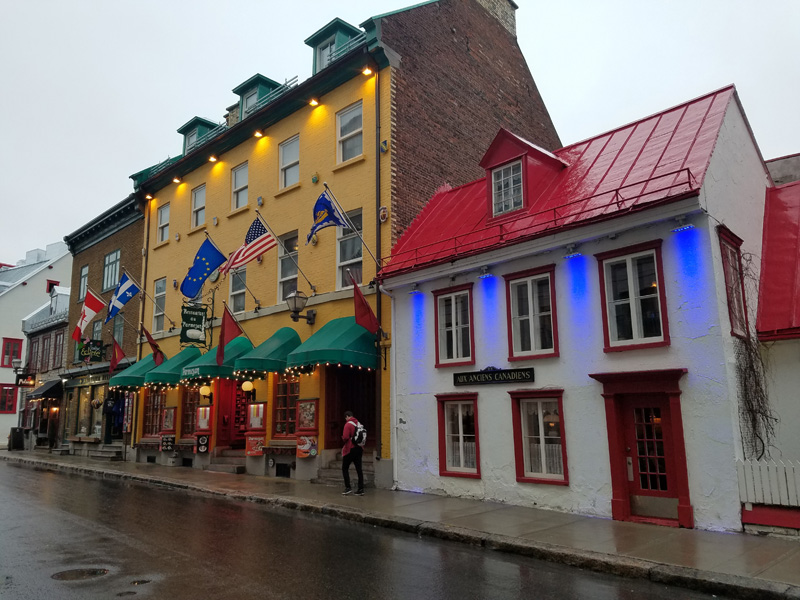
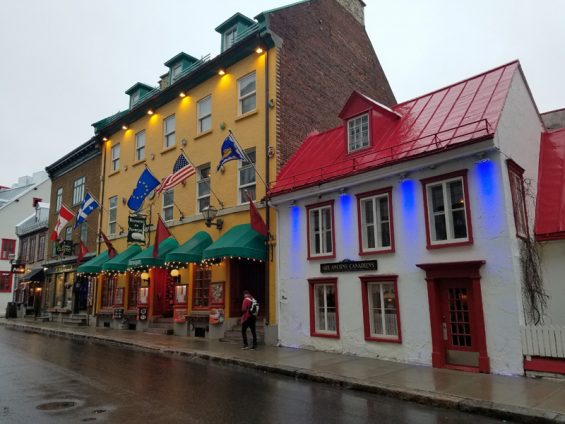
Quebec City is photogenic even in a downpour
I’m always looking for ways to piggyback vacation days onto business trips and speaking gigs, but sometimes the locations of business functions are something less than vacation-worthy. But when the organizers of the Women in Travel Summit announced that the 2018 conference would be in Quebec City, I knew I had a destination worthy of those stashed-away vacation days, and that my husband, Floren, could join me for a few of them. Here’s what we did with 4 days in Quebec City.
Day 1 in Quebec City
Although Floren enjoys teasing me for my “so American” habit of checking the weather forecast obsessively (Europeans, he tells me in his nonchalant-Spaniard way, simply look out the window), we can both thank my Arcus fixation for keeping us from descending into hypothermia. It was sunny and 80 degrees when we left Boston; Quebec City, by contrast, was about 45 degrees, rainy, and windy for most of the time we were there.
We took an Uber from the airport to our hotel, and as we would discover on the way back, when we rented a car and drove ourselves the roughly 15 minutes back to the airport, taxi drivers here seem to prefer the scenic (read: way-too-long-way-around) route.
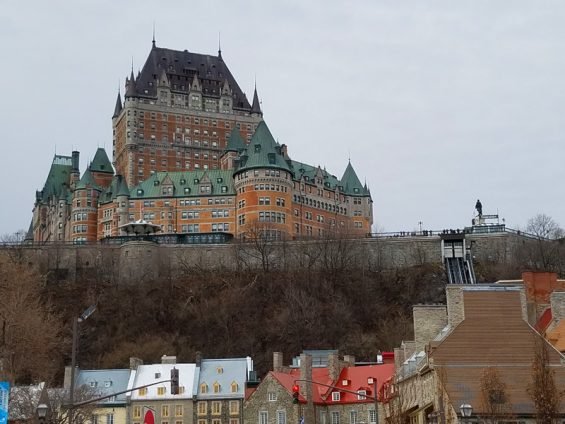
Fairmont Le Chateau Frontenac
The conference was at the Fairmont Le Chateau Frontenac, the impossible-to-miss European-inspired castle that stands guard over the historic part of the city. The hotel is spectacular, at least in its common areas. I can’t speak to the rooms, since the rate (plus two additional taxes, one about 14% and the other 3%; be aware of this when booking your hotel in Canada). Luxury is lovely and all, and several of the conference attendees I spoke to loved their stay at the Chateau. But in general when traveling, I prefer to cap the hotel fees at $120 per night. My theory: I don’t spend much time in the hotel room, anyway, and going cheaper on lodgings means I have more money to spend on the important things, such as food, activities, museums, food, side trips, and gifts. And food.
So we headed just across the street to the Hotel Sainte-Anne, a boutique hotel that clocked in at about $40 less per night, despite including a full breakfast (with about 10 choices, all with fresh fruit) in its price, and is ideally located to anything you might want to walk to in the city. We chose a Superior Room, with original brick walls and a view of the Rue Sainte-Anne. It was comfortable, spacious, and well insulated from noise, though it could have benefitted from better lighting and a larger closet (the one provided, about 10 inches wide, is definitely better suited to solo travelers).
The service staff at the Sainte-Anne is on the younger side, so they frequently had to confer with more mature staffers on questions, but they were polite and helpful. For our part, we were thankful we could jog back to our room whenever the weather got ugly.
And it did. Almost as soon as we stepped outside to explore. We hightailed it a few blocks away to Chez Temporel, which some helpful Yelpers had given high marks, for a late lunch.
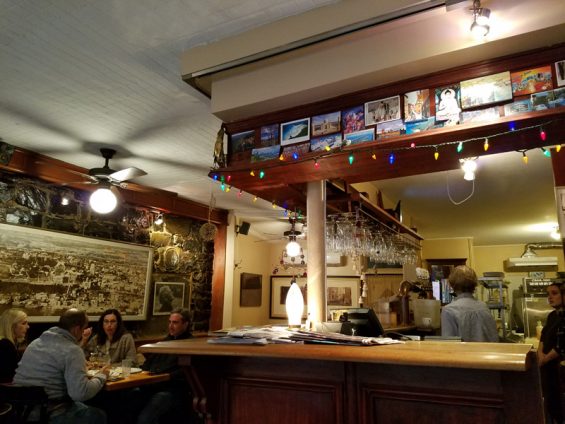
Chez Temporel
This Old World-style bistro turned out to be a terrific—and terrifically warm—spot for people watching through the front window while snacking on quiche and cheese-smothered breads. Save for the table of Argentine tourists across the room, we were the only folks in the place, and that suited us just fine.
Refueled, we geared up in our winter coats and headed back outside. . . . Where it promptly began to pour. Ducking under awnings only did so much to prevent us from the driving rain, so we took a detour into Baguette & Chocolat, where we warmed up with a tea. But another half hour or so later, the rain still wasn’t showing any signs of letting up.
We headed back to the hotel and asked to borrow an umbrella, and were a little taken aback at having to fork over a $20 deposit for a compact umbrella that promptly blew inside-out in the storm. The lesson here: Bring your own umbrella, and make sure it’s a sturdy one, if you’re planning to walk near the St. Lawrence.
After another hour or so of trying to hang on to the edges of the umbrella and brave the icy-cold winds off the St. Lawrence while walking the streets and along the boardwalk in front of the Chateau Frontenac, we started to wonder if 4 days in Quebec City was a good idea. We decided to regroup, and dry off, back at the hotel.
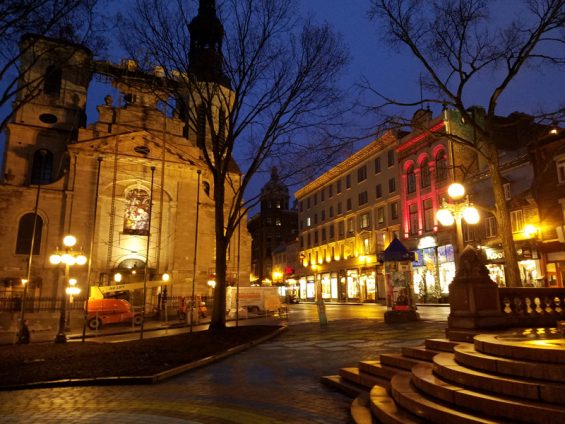
Quebec City at night
Though we usually prefer to spend as little time at our hotel as possible, the rain continued into the evening. We used the last couple of hours before dinner to search around for what to do with our time in the city, and make a game plan for the next day (the Sainte-Anne has great WiFi, which made planning a breeze). Once dinner time rolled around, again following recommendations on Yelp, we pulled up our hoods and made the trip on foot through the puddle-ridden streets—which are extraordinarily photogenic in the rain—to Les Gourmandises Louca, one of Quebec City’s only vegan food options. The young hipster guy running the counter was a sweetheart, but the food . . . the less said the better. We eat vegan at home, so we know it’s not difficult to make a flavorful, no-meat, no-dairy meal, and Louca did not pass muster.
Disappointed, cold, and a little cranky, we decided to throw in the soggy towel and go back to the hotel for a hot shower and some Netflix.
Day 2 in Quebec City
Though the rain continued throughout the night, by morning it had subsided to a drizzle. Mercifully, the wind had also died down and the temperature wasn’t quite so bitter, so we went out to get the lay of the land.
Returning to the boardwalk, we took the stairs at the end to an extraordinarily well-maintained walking platform/path with views of the St. Lawrence. This leads to the Plains of Abraham, a former battlefield where British soldiers took the French army by surprise in 1759.

A staircase from the boardwalk in front of Chateau Frontenac, which leads to the Plains of Abraham
We had the place nearly to ourselves, so we took an easy stroll across the park and past La Citadelle de Quebec, Quebec City’s active military outpost. Walking in a nearly straight line took us down to the Parliament Building. I would have like to stop for a quick tour, but the front of the building was blocked by multiple construction vehicles, so we kept moving to the remnants of the fortifications of Quebec, a series of wall fragments and lookouts over the city.
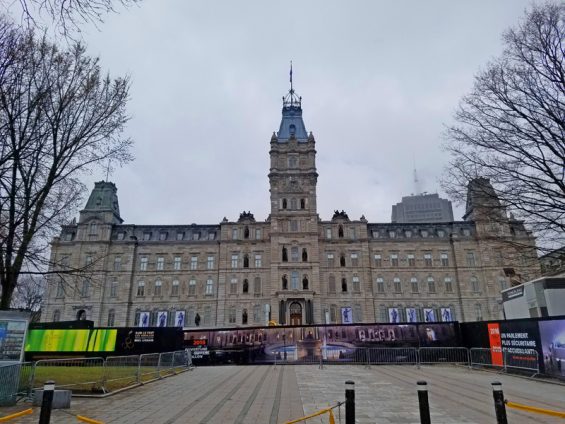
Parliament Building
We weren’t super excited by the menus posted on the restaurants we passed while walking back into the city, but with the hangries threatening to overtake us, we stopped at La Galette Libanaise, a Lebanese deli featuring flatbread sandwiches and baklava. Lots of baklava. As in, an entire set of glass display cases dedicated to it. Lunch was enjoyable and inexpensive—I had falafel (more like a spiced chickpea spread than fried dumplings, but still good); Floren had a marinated salmon wrap.
Once a book nerd, always a book nerd, so we headed to the Morrin Centre. Originally built as a prison 200 years ago, the Morrin is a cultural center and library that houses an eclectic selection of books, including several dozen that date to the sixteenth century. I loved this little gem, not only for its ability to shelter us from the rain without having to buy anything, but for its hushed, soothing atmosphere. And the books—wall to wall and floor to ceiling, there were enough books to keep me busy for a lifetime.
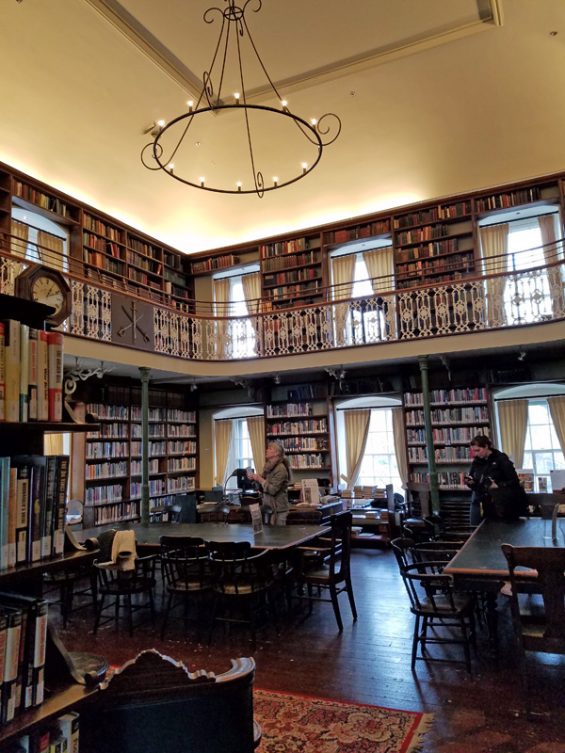
The Morrin Centre
I would have liked to have taken the tour of the Morrin’s historic jail rooms and warrens, but tours are only given on weekends. This is a common theme in Quebec City (the Chateau Frontenac, for example, also conducts tours only on weekends), and I’m not sure if it’s always this way or simply because May is considered the off season. Either way, it’s a bit of a let-down.
With a few hours of daylight left, we headed to Quartier Petit Champlain, the oldest shopping district on the continent and a charming mini maze of cobblestone streets, stucco buildings, and European plazas.
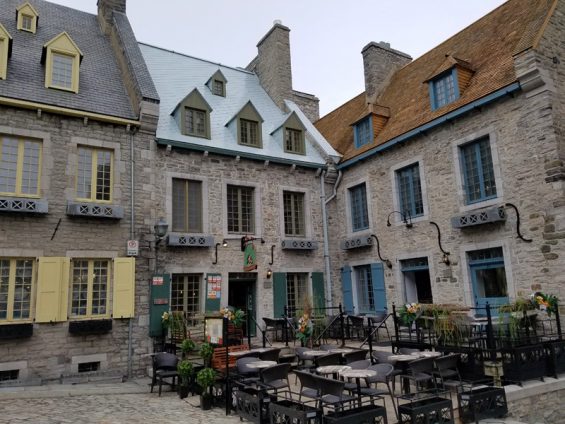
A picturesque corner of Quartier Petit Champlain
This is definitely the place for die-hard shoppers—from clothes and accessories to gemstones and geodes, Petit Champlain seems to have a shop for everything. This gives it an unmistakably tourist feel, so we detoured into only a few shops. The one that caught our attention enough to spend a good 20 minutes or so inside was Galerie Dugal, which sells high-end wood sculptures, carvings, and some pretty incredible handcrafted furniture.
We finished our city circuit with a walk down to the port, with its infinitely Instagrammable views of the Frontenac perched atop the hill (see top of post).
That evening, following a WITS all-hands meeting for conference speakers, sponsors, and volunteers, my colleagues and I gathered in Le Cellier du Chateau, the Frontenac’s stately wine cellar. All walnut-toned woods, high ceilings, chunky club furniture, and gleaming tile floors, it’s where I envision circa-1800s politicians and city VIPs congregating.
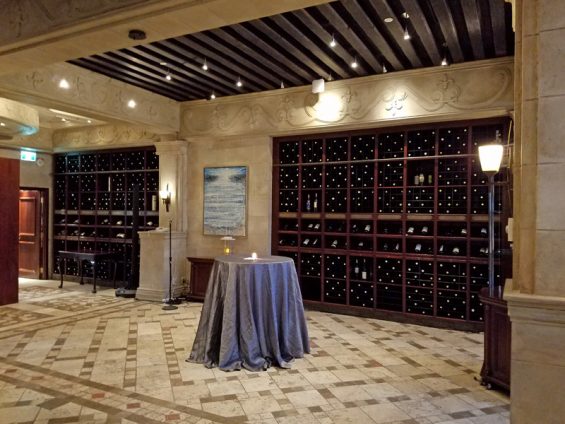
Le Cellier at Chateau Frontenac
Since large parties generally don’t float my food-snob boat, and the rain had starting sheeting down again, I skipped the opening party for a relaxed dinner with the hubs. We ran—literally—around the corner from our hotel to Café Buade, where we comforted our waterlogged selves with fish and chips and fries.
Day 3 in Quebec City
I was at WITS for most of the day, so so our third of 4 days in Quebec City is a bit of a cheat (more on that later). I will point out, however, that the ballrooms and conference rooms at the Chateau Frontenac are impressively grand and character-filled, and the lunch beats most hotels (and conference food in general) by miles.
With this being another chilly, windy day, Floren opted to stick close to already-established routes. He whiled away a couple of hours at the Morrin, then relaxed in a nearby green space for a bit before taking in a leisurely lunch.
As dinnertime approached, we discovered that even in the off season, getting a table at a restaurant in Quebec City on a weekend is about as likely as finding a Canadian grocery store that doesn’t have an entire aisle dedicated to maple products. Luckily, Louise Taverne, down by the water, was kind enough to squeeze us in between reservations, and turned out to be the one of the best meals we had in QC. The portions were smaller than expected for the price, but as is also the case with Stateside trendy bars and restaurants, the dishes were unique and beautifully presented.
We followed up with a slow stroll back through the city, with pit stop at Chocolato, a chocolate and ice cream bar that boasts a dozen gelatos and sorbets and 20 dipping sauces that harden to a delightfully crunchy coating. Mainstream? Sure. But worth the stop for a post-meal sweet treat that won’t break the bank.
Day 4 in Quebec City
With my conference attendance wrapped around noon, Floren and I decided to spend our last day with a little side trip. We picked up a car at Hertz, next to the elegant Hotel Manoir Victoria—and got a pretty snazzy upgrade, probably because their compact fleet was already spoken for—and headed out of the city proper for Ile d’Orleans, an agricultural peninsula just 20 minutes’ ride away.
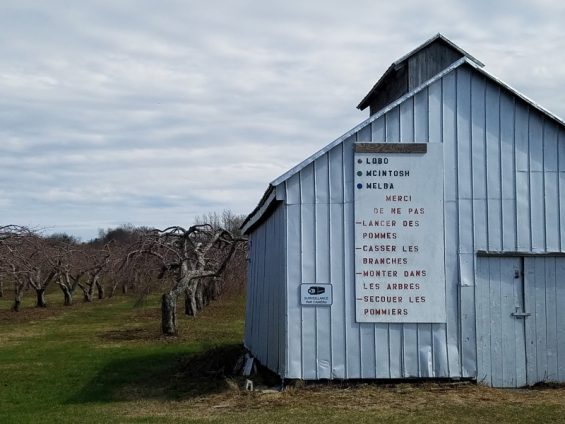
One of the many orchards on Ile d’Orleans. Don’t even think of throwing apples.
Orleans, with its rambling farmsteads and rocky coast, is postcard-beautiful, and the tourism bureau has wisely planted signs all around the main road, the Chemin Royal, alerting visitors to its various lookouts, shorefronts, and towers with panoramic views. Having grown up on the New England coast, I’m always drawn to the water, and loved walking along the shore here, despite the continued chilly, windy weather.
What makes Orleans such a worthy side trip is the many farms, farm stands, and vineyards where you can stop for snacks and boozy samples . . . at least in season. Early May, it turns out, is not the best time to visit Ile d’Orleans, so we didn’t get to enjoy any local dishes. We did, however, enjoy a stop at Domaine Steinbach, a cider house where we tried a flight of hard ciders, including a dessert-y ice cider, plus a couple dozen house-made mustards, pates, and jams. The standout: the Maple and Onion Preserves, of which I would have bought a tote bag full if I thought I could sneak it past the TSA. If you can visit during the warmer months, check out The Porches of Ile d’Orleans: Seeing the Island through its Windows and Doors while Walking Chemin Royal, a little gem of a book that offers an alternate story of Orleans, as told through the porches and windows of its habitants
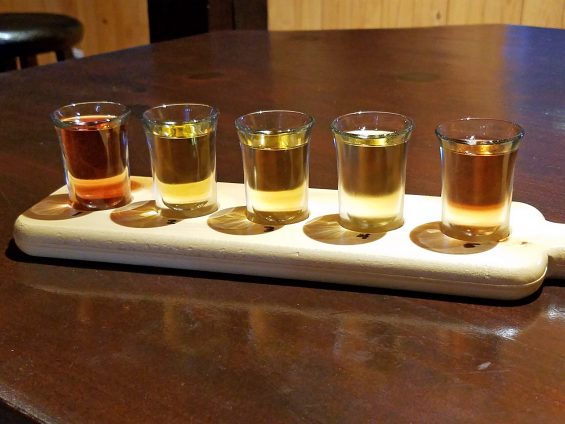
A flight of ciders at Domaine Steinbach, Ile d’Orleans
After leaving the island, we headed diagonally across the bridge for a stop at Montmorency Falls, or Chutes Montmorency, as it’s known in French. A hundred feet taller and every bit as dramatic as Niagara, Montmorency Falls is worth viewing from all angles—down below, where the water bouncing off the rocks sprays miniature raindrops over your face (and, in my case, glasses; wear your contacts for this trip); on the suspension bridge above, past the Montmorency Mansion (which offers dining, with spectacular views, in season), where you can peer over the railings at the rushing water and feel the whooshing force beneath your feet; and on the staircases and lookouts along the sides, where you’re awed by your tininess as you contemplate the massive scale of the water.
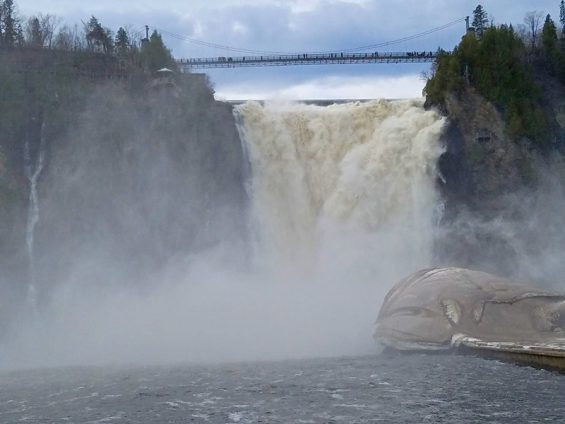
Montmorency Falls, just 15 mintues north of Quebec City
Happily tired from spending the day in the sun and wind, we decided to skip a long walk to find a restaurant and opted to eat at the hotel’s Le Grille Sainte Anne. This meal—quick, fresh, flavorful, and perfectly cooked—was one of the biggest surprises in a city that’s not as food-fabulous (at least not for vegetarians and vegans) as its gorgeous architecture and scenic streets might lead you to believe, and a great way to cap off the day.
4 Days in Quebec City: A Wrap-up
Had I not also attended the conference, we could have done this Quebec City trip in three days (Fodor’s Montreal and Quebec City even makes the case) and still felt like we saw what we most wanted to see. If you’re a shopper, you might want to plan an extra day or so to check out the dozens of galleries and boutiques that line nearly every street of the city, but the city is pretty small, so lots of extra time probably isn’t needed.
For non-shoppers, getting out into the natural world tends to be the MO, and for this reason, I strongly recommend waiting until at least June to make the trip. Much like that of the Northeastern US, Quebec City’s weather is pretty volatile in winter and spring, and you’ll be a lot more comfortable if you don’t have to travel with heavy layers or find places to dart into whenever the rain and wind kick up a fuss. You’ll also be able to spend more time exploring Ile d’Orleans, which I really would have liked to do.
Still, even in uncooperative weather, Quebec City is a pleasant, laid-back place—an easily walkable city with several attractions, a sense of history, and the country’s signature Canadian politeness—to spend a few days and take some memorable travel photos.
